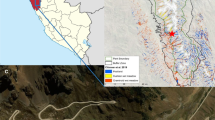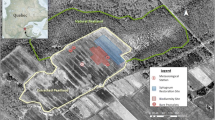Abstract
Background & Aim
Vascular plants may reduce episodic ebullition losses of methane (CH4) from peatlands. They transport CH4 to the atmosphere, which may lead to a reduction in pore-water [CH4], bubble formation and release. This effect may be compounded by rhizospheric oxidation and associated methanotrophy. However, any reduction in pore-water [CH4] may be countered by root exudation (substrate for methanogens). The aim of this study was to determine how the presence of sedges affects CH4 emissions from peatlands.
Methods
Five pairs of peat cores were collected from a raised bog. One of each pair contained Sphagnum cuspidatum and Eriophorum angustifolium (‘sedge’ cores); the other was dominated by S. cuspidatum (‘no-sedge’). From these the total CH4 efflux—including that due to episodic ebullition—were measured. A partial-shading treatment helped isolate the potential effect of root exudation.
Results
Sedge samples had significantly higher CH4 fluxes than no-sedge samples, but episodic-ebullition fluxes were not significantly different. Between full-light and partially-shaded conditions, there was a significant increase in the difference in CH4 fluxes between the sedge and no-sedge cores.
Conclusion
The higher rates of CH4 flux from the sedge cores cannot be explained simply by higher rates of CH4 production due to rapid utilisation of exudates.





Similar content being viewed by others
References
Baird AJ, Beckwith CW, Waldron S, Waddington JM (2004) Ebullition of methane-containing gas bubbles from near-surface Sphagnum peat. Geophys Res Lett 31:L21505. doi:10.1029/2004GL021157
Belyea LR, Clymo RS (2001) Feedback control of the rate of peat formation. Proc R Soc Lond B 268:1315–1321
Bochem HP, Schoberth SM, Sprey B, Wengler P (1982) Thermophilic biomethanation of acetic acid: morphology and ultrastructure of a granular consortium. Can J Microbiol 28:500–510
Chanton JP (2005) The effect of gas transport on the isotope signature of methane in wetlands. Org Geochem 36:753–768
Chanton JP, Arkebauer TJ, Harden H, Verma SB (2002) Diel variation in lacunal CH4 and CO2 concentration and δ13C in Phragmites australis. Biogeochemistry 59:287–301
Christensen TR, Panikov N, Mastepanov M, Joabsson A, Stewart A, Öquist M, Sommerkorn M, Reynaud S, Svensson B (2003) Biotic controls on CO2 and CH4 exchange in wetlands—a closed environment study. Biogeochemistry 64:337–354
Coulthard TJ, Baird AJ, Ramirez J, Waddington M (2009) Methane dynamics in peat: importance of shallow peats and a novel reduced-complexity approach for modeling ebullition. In: Baird AJ, Belyea LR, Comas X, Reeve AS, Slater LD (eds) Carbon cycling in northern peatlands, Geophysical Monograph Series 184. AGU, Washington DC, pp 173–185. doi:10.1029/2008GM000826
AEA Energy and Environment (2007) UK Acid Deposition Monitoring Network:Data Summary 2006. Report to the Department for Environment, Food and Rural Affairs and the Devolved AdministrationsAEAT/ENV/R/2534 ED48750 Issue 2.
Frenzel P, Rudolph J (1998) Methane emission from a wetland plant: the role of CH4 oxidation in Eriophorum. Plant and Soil 202:27–32
Frye JP, Mills AL, Odum WE (1994) Methane flux in Peltandra virginica (Araceae) wetlands: Comparison of field data with a mathematical model. Am J Bot 81(4):407–413
Green SM, Baird AJ (2011 in review) The importance of episodic ebullition methane losses from three peatland microhabitats—a controlled environment study. Biogeosciences. Submitted for publication.
Greenup AL, Bradford MA, McNamara NP, Ineson P, Lee JA (2000) The role of Eriophorum vaginatum in CH4 flux from an ombrotrophic peatland. Plant and Soil 227:265–272
Jackson MB, Armstrong W (1999) Formation of aerenchyma and the processes of plant ventilation in relation to soil flooding and submergence. Plant Biology 1:274–287
Joabsson A, Christensen TR (2001) Methane emissions from wetlands and their relationship with vascular plants: an Arctic example. Glob Chang Biol 7:919–932
Joabsson A, Christensen TR, Wallén B (1999) Influence of vascular plant photosynthetic rate on CH4 emission from peat monoliths from southern boreal Sweden. Polar Research 18:215–220
Lambers H, Chapin FS, Pons T (1998) Plant physiological ecology. Springer, New York
Limpens J, Berendse F, Klees H (2003) N deposition affects N availability in interstitial water, growth of Sphagnum and invasion of vascular plants in bog vegetation. New Phytologist 157:339–347
Nouchi I, Mariko S, Aoki K (1990) Mechanism of methane transport from the rhizosphere to the atmosphere through rice plants. Plant Physiology 94:59–66
Öquist MG, Svensson B (2002) Vascular plants as regulators of methane emissions from a subarctic mire ecosystem. J Geophys Res 107(21):4580–4590
Popp TJ, Chanton JP, Whiting GJ, Grant N (2000) Evaluation of methane oxidation in the rhizosphere of a Carex dominated fen in north central Alberta, Canada. Biogeochemistry 51:259–281
Rosenberry DO, Glaser PH, Siegel DI (2006) The hydrology of northern peatlands as affected by biogenic gas: current developments and research needs. Hydrol Process 20:3601–3610
Schimel JP (1995) Plant transport and methane production as controls on methane flux from Arctic wet meadow tundra. Biogeochemistry 28:183–200
Strack M, Waller MF, Waddington JM (2006) Sedge succession and peatland methane dynamics: A potential feedback to climate change. Ecosystems 9:278–287. doi:10.1007/s10021-005-0070-1
Ström L, Ekberg A, Mastepanov ML, Christensen TR (2003) The effect of vascular plants on carbon turnover and methane emissions from a tundra wetland. Glob Chang Biol 9:1185–1192
Ström L, Mastepanov M, Christensen TR (2005) Species-specific effects of vascular plants on carbon turnover and methane emissions from wetlands. Biogeochemistry 75:65–82
Thomas KL, Benstead J, Davies KL, Lloyd D (1996) Role of wetland plants in the diurnal control of CH4 and CO2 fluxes in peat. Soil Biol Biochem 28:17–23
Tokida T, Miyazaki T, Mizoguchi M (2005) Ebullition of methane from peat with falling atmospheric pressure. Geophys Res Lett 32:L13823. doi:10.1029/2005/GL022949
Waddington JM, Roulet NT, Swanson RV (1996) Water table control of CH4 emission enhancement by vascular plants in boreal peatlands. J Geophys Res 101(D17):22775–22785
Walter BP, Heimann M, Shannon RD, White JR (1996) A process-based model to derive methane emissions from natural wetlands. Geophys Res Lett 23:3731–3734
Wheeler BD (1999) Water and plants in freshwater wetlands. In: Baird AJ, Wilby RL (eds) Eco-hydrology: plants and water in terrestrial and aquatic environments. Routledge, London, pp 127–180
Whiting GJ, Chanton JP (1992) Plant-dependent CH4 emission in a subarctic Canadian fen. Global Biogeochem Cycles 6:225–231
Acknowledgements
The UK Natural Environment Research Council funded the research reported in this paper under grant NE/F003390/2. We are grateful to Scottish Natural Heritage for granting permission to take peat samples from Longbridgemuir. Dr Nick Kettridge and Professor Andrew Binley helped extract the peat cores.
Author information
Authors and Affiliations
Corresponding author
Additional information
Responsible Editor: Hans Lambers.
Rights and permissions
About this article
Cite this article
Green, S.M., Baird, A.J. A mesocosm study of the role of the sedge Eriophorum angustifolium in the efflux of methane—including that due to episodic ebullition—from peatlands. Plant Soil 351, 207–218 (2012). https://doi.org/10.1007/s11104-011-0945-1
Received:
Accepted:
Published:
Issue Date:
DOI: https://doi.org/10.1007/s11104-011-0945-1




